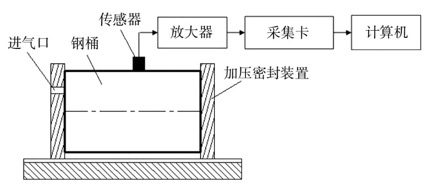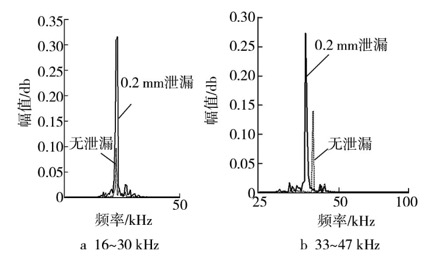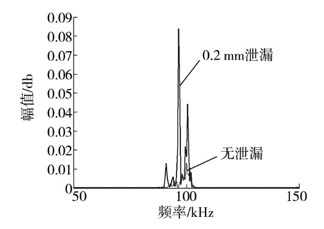Steel Drum Leak Detection Using Acoustic Emission Signals
Chen Yangyang
Abstract: This study aims to develop a method for detecting leaks in steel drums using acoustic emission signals. A system was set up using an acoustic emission sensor, preamplifier, data acquisition card, and computer. The system was tested with a leakage diameter of 0.2 mm, and the corresponding acoustic emission signals were collected. These signals were decomposed using wavelet packet analysis, and energy features from three frequency bands (16–30 kHz, 33–47 kHz, and 95–102 kHz) were extracted as input features for a support vector machine (SVM). The trained SVM model was used to classify whether a steel drum was leaking. The results showed that the system achieved a 100% accuracy rate in detecting leaks. The combination of wavelet packet energy and SVM proved effective in identifying even small leaks in steel drums.
Keywords: steel drum leak; acoustic emission; wavelet packet energy; support vector machine
Steel drums are widely used in industries such as chemicals, petroleum, and food due to their high strength, corrosion resistance, and reliability. Real-time leak detection is crucial for ensuring safety and product integrity. Traditional methods like the soap test or sound method have limitations in sensitivity and accuracy. In this research, acoustic emission technology was applied to detect leaks by capturing stress waves generated when fluid escapes through a leak under pressure. These waves propagate along the drum wall and contain valuable information about the leak. By analyzing time-domain, frequency-domain, and time-frequency-domain characteristics, it is possible to extract key features for classification. Using wavelet packet decomposition and SVM, the system successfully detected leaks with a diameter as small as 0.2 mm.
1 Wavelet Packet Decomposition and Support Vector Machine Theory
1.1 Principle of Wavelet Packet Energy Extraction
Wavelet packet decomposition is an advanced technique based on multi-resolution analysis, allowing detailed frequency band decomposition without signal leakage. It provides high-resolution time-frequency information. The process involves decomposing the signal into multiple frequency bands, calculating the local energy in each band, and forming a feature vector for pattern recognition.
1.2 Support Vector Machine Theory
Support Vector Machines (SVMs) are powerful classifiers rooted in statistical learning theory, particularly effective for small sample datasets. They map input vectors into high-dimensional space using kernel functions, enabling accurate classification. SVMs have been widely applied in fault detection, including leak identification, due to their robustness and high accuracy.
2 Steel Drum Leak Test and Analysis
2.1 Test Plan
The experiment involved both leak-free and 0.2 mm-leaking steel drums. An acoustic emission sensor (SR150, 150 kHz center frequency), a preamplifier (40 dB gain), and a data acquisition card (NI-PCI6251, 1 MS/s sampling rate) were used. Gas was introduced into the drum at a pressure of 0.15 MPa, and acoustic emission signals were recorded over time.

Figure 1: Schematic of the steel drum leakage testing device
2.2 Leak Feature Extraction
The collected signals spanned a wide frequency range (0–500 kHz). By comparing the spectra of leaking and non-leaking drums, significant differences were observed in three frequency bands: 16–30 kHz, 33–47 kHz, and 95–102 kHz. Using a 5-layer wavelet packet decomposition with db9 wavelets, the energy in these bands was calculated. The results showed that the energy in the leaking state was significantly higher than in the non-leaking state.

Figure 2: Comparison of power spectra between 0.2 mm leak and no leak

Figure 3: Power spectrum comparison in the 95–102 kHz band
2.3 Leak Identification
With 20 sets of acoustic emission data, the energy from the three frequency bands was extracted as feature vectors. A radial basis function (RBF) kernel was used in the SVM classifier, with parameters set to 2 and 0.5 respectively. The training set included 50 samples, and the test set had 10 samples. All tests were correctly classified, achieving 100% accuracy.
Table 2: Classification results of 20 test samples using SVM
Leakage State
Data
E1/J
E2/J
E3/J
Classification Result
Recognition Result
Leak-Free Steel Drum
1
3.079
1.690
0.888
+1
Correct
2
1.510
1.074
0.803
+1
Correct
...
0.2mm Leaking Steel Drum
1
4.905
6.930
4.211
-1
Correct
...
3 Conclusion
The acoustic emission signals from leaking steel drums appear as frequency bands rather than specific frequencies. By extracting energy features from three key frequency bands and using SVM for classification, the system achieved 100% accuracy in detecting leaks with a diameter of 0.2 mm. This method proves to be reliable and effective for real-time leak detection in industrial applications.
1. Environmentally friendly: Bagasse pulp containers are made from a renewable resource and are biodegradable. They do not contribute to the accumulation of plastic waste and can be composted, reducing the burden on landfills.
2. Sustainable production: Sugarcane is a fast-growing crop that requires minimal water and fertilizer compared to other crops. Using bagasse pulp containers helps promote sustainable agriculture practices.
3. Heat resistance: Bagasse Pulp Container have excellent heat resistance properties. They can withstand high temperatures without deforming or releasing harmful chemicals, making them suitable for hot food and beverages.
4. Versatility: Bagasse pulp containers come in various shapes and sizes, making them suitable for a wide range of food and beverage applications. They can be used for takeaway containers, plates, bowls, cups, and more.
5. Insulation properties: Sugarcane pulp containers have natural insulation properties, helping to keep food and beverages hot or cold for longer periods. This feature is especially beneficial for takeaway or delivery services.
6. Sturdy and durable: Despite being lightweight, bagasse pulp containers are strong and durable. They can hold heavy or saucy foods without leaking or breaking, ensuring a reliable and secure packaging solution.
7. Microwavable and freezer-safe: Bagasse pulp containers are microwave and freezer-safe, making them convenient for reheating or storing leftovers.
8. Cost-effective: Bagasse pulp containers are cost-effective compared to other eco-friendly alternatives like compostable plastics. They are competitively priced and readily available in the market.
9. Positive brand image: Using bagasse pulp containers demonstrates a commitment to sustainability and environmental responsibility. This can enhance a brand's reputation and attract eco-conscious customers.
10. Regulatory compliance: Bagasse pulp containers meet food safety regulations and standards. They are FDA approved and do not contain any harmful chemicals or toxins that could leach into food or beverages.1. Environmentally friendly: Bagasse pulp containers are made from a renewable resource and are biodegradable. They do not contribute to the accumulation of plastic waste and can be composted, reducing the burden on landfills.
2. Sustainable production: Sugarcane is a fast-growing crop that requires minimal water and fertilizer compared to other crops. Using bagasse pulp containers helps promote sustainable agriculture practices.
3. Heat resistance: Bagasse pulp containers have excellent heat resistance properties. They can withstand high temperatures without deforming or releasing harmful chemicals, making them suitable for hot food and beverages.
4. Versatility: Bagasse pulp containers come in various shapes and sizes, making them suitable for a wide range of food and beverage applications. They can be used for takeaway containers, plates, bowls, cups, and more.
5. Insulation properties: Bagasse food container have natural insulation properties, helping to keep food and beverages hot or cold for longer periods. This feature is especially beneficial for takeaway or delivery services.
6. Sturdy and durable: Despite being lightweight, bagasse pulp containers are strong and durable. They can hold heavy or saucy foods without leaking or breaking, ensuring a reliable and secure packaging solution.
7. Microwavable and freezer-safe: Bagasse pulp containers are microwave and freezer-safe, making them convenient for reheating or storing leftovers.
8. Cost-effective: Bagasse pulp containers are cost-effective compared to other eco-friendly alternatives like compostable plastics. They are competitively priced and readily available in the market.
9. Positive brand image: Using bagasse pulp containers demonstrates a commitment to sustainability and environmental responsibility. This can enhance a brand's reputation and attract eco-conscious customers.
10. Regulatory compliance: Bagasse pulp containers meet food safety regulations and standards. They are FDA approved and do not contain any harmful chemicals or toxins that could leach into food or beverages.
Bagasse Pulp Salad Container,Biodegradable Salad Bowl,Bagasse Pulp Salad Bowl,Sugarcane Fiber Salad Bowl
EVER GREEN(ZHEJIANG)NEW MATERIAL CO., LTD / KUNSHAN GREENPACK CO.,LTD , https://www.changjingpack.com